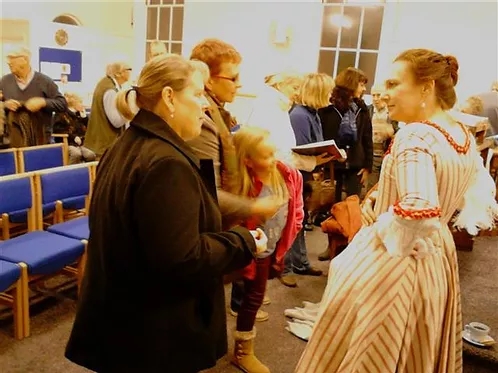|
 (Above: Molly Housego in costume) (Below: examining the clothes)  |
[Return
to home page] |
The Georgian Lady: Costumes and Manners in the 18th Century
November 2014
I was tempted to sub-title this "What Molly Did Next", as it was Molly Housego's popularly demanded return visit, following her well-remembered performance as Ann Boleyn two years ago. Thirty or so ladies and seven brave men were comfortably seated in the Methodist Chapel, greeting our dramatically dressed speaker with spontaneous applause before she had spoken a single word. Grace, our school-girl member, was there, as you would expect. What a pity more young people were not able to attend as these performances really bring history to life - but I do believe that Molly visits local schools.
The fashions of the middle class ladies in this most elegant period in history were expertly explained and equally elegantly modelled. Discussing female attire in such detail may be thought to be dull, maybe even a little embarrassing, by the average 21st Century male, but neither proved to be the case. The over-riding impression as that which I often form when contemplating female fashions, especially in a historical context: what a chore it all was, but were they not remarkably clever!
Now, as a mere male, I'm not going to attempt to go into a lot of technical detail, but a few facts stayed with me. We discovered that, beneath their elaborate costume, Georgian ladies wore stays. These were not those horrible waist-pinching, organ-crushing things called corsets, invented by the Victorians. Although reinforced by whalebone or even steel, stays were a much more natural shape and actually very comfortable. Molly told us that she had ridden a horse whilst wearing stays and, to save time, had actually driven to our meeting so attired. Their job seemed to be to gently shape and to act as the firm foundation to which other parts of the overall costume were attached.
Pins were much in evidence. Amorous suitors needed to beware: those ladies were held together by pins. Above the waist was a nicely tailored bodice, but in front and below what looked like a dress was an assemblage of pieces of linen or silk, pinned to the stays or tied round the waist and then fixed into elaborate drapes and bunches. Remove a few pins and ties and suddenly the dress acquired a train several feet long. Clever.
Just as Jane Austen told us, ribbons were in high demand: to tie on your bonnet, to keep up your stockings, to join various bits together, to weave into decorations and generally to convert last year's old dress into this year's height of fashion. Clothes were expensive, difficult to clean and had to be made to last. For the ordinary girl, ribbons were the answer.
After the talk, Molly was overwhelmed with questions and then besieged by ladies examining the clothes, many of which she had made herself with great attention to period detail. There was talk of her coming again to cover another period, but maybe as a double act to let men's historical wear get into the picture as well.
Noel Mitchell
(Above: Molly Housego in costume)
(Below: examining the clothes)
[Return to home page]